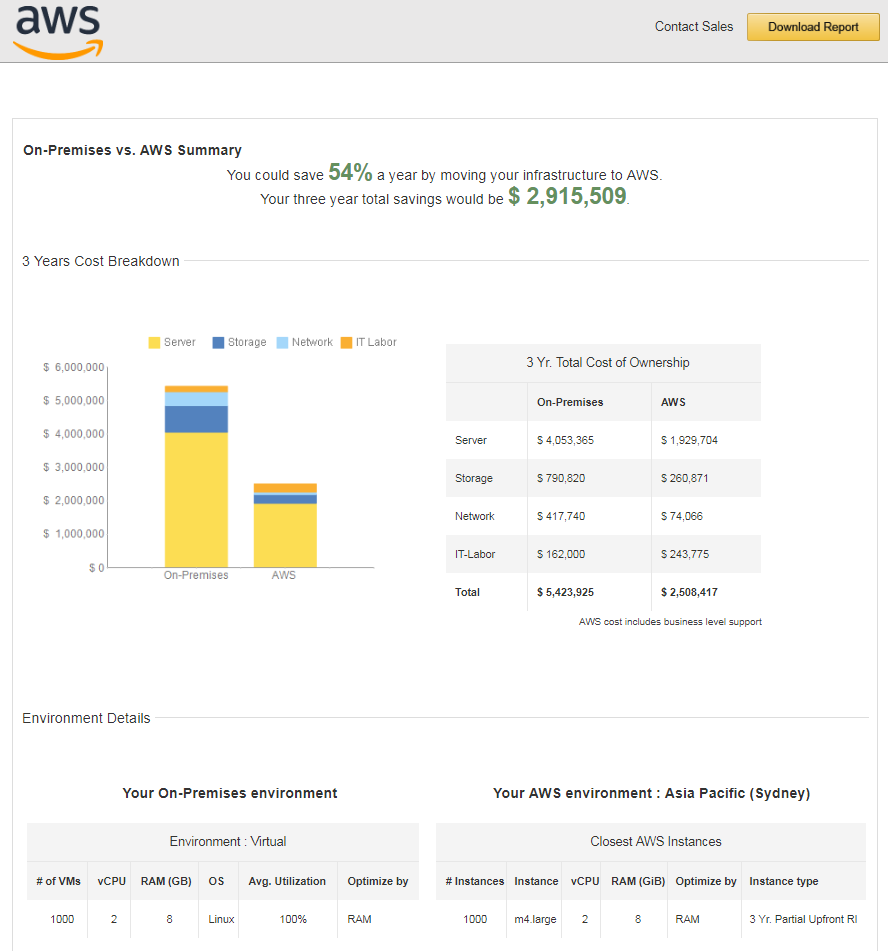- On-premises with low cost infrastructure and small devops team
- VMware Cloud (VMC) on AWS - 3 year subscription
- AWS EC2 - 3 year reserved instances
- 2 vCPUs
- 8 GB memory
- 200 GB storage @ 300 IOPS
Hence we need:
- 2000 vCPUs
- 8 TB memory
- 200 TB @ 300,000 IOPS
Option 1 - Low cost on-prem infrastructure - $2.58m
Here are some rough costs for high performance infrastructure to support 1000 VMs in an enterprise environment including backup:
- Hardware: $1,050K
- VMware Software: $180K
- Backup Software: $125K
- Data Center: $350K
- Staff: assume only 1.5 FTE equivalents (1 FTE = $100K + 40% uplift) - $630K
- Other (Misc): $100K
- Install: $150K
The above solution is based on low cost commodity infrastructure and small, agile devops team to manage the infrastructure:
- Low data center costs by utilising fewer racks in an outsourced high quality data center (maybe even use the same data centers that AWS use, hence low latency to AWS)
- Low staff costs by utilisating high level of automation of small devops team and very simple architecture
- Low cost networking
- Low cost backups with commodity software and hardware
- Low cost load balancer costs (above uses open source HAProxy - same as NSX)
- Low cost, high performance storage (above uses competitive storage and does not use SAN fabric)
- Simple architecture
Typical enterprise IT infrastructure is significantly more expensive as it is based on expensive legacy "big brand" products, are inefficient and require vast number of people to support. Typical enterprise infrastructure have high cost due to:
- Servers: Expensive blade servers that are complex, expensive hyperconverged servers or even worse proprietary servers (IBM p/i/z-Series, HP Itanium, Oracle SPARC).
- Storage: Expensive storage and SAN fabric (EMC, IBM, HDS, Netapp, Oracle, HPE, Brocade, Cisco).
- Networking: Expensive networking (Big, expensive Cisco switches, F5 load balancers)
- Backup: Expensive backups (IBM TSM, HPE Data Protector, Veritas Netbackup, EMC Avamar) with expensive libraries/appliances.
- Data Center: Expensive internal data center or even outsourced data center with up to hundred racks or more with low level of utilisation.
- Staff: Large number of IT infrstraucture staff working in many silos of IT teams including dedicated staff for procurement, architecture, facilities, networking, storage, backup, server management, VMware management. IT silos need to coordinate the activities between the teams hence are slow to provide business outcomes.
Based on requirements the VMware sizer and cost calculator produced the following:
Please note that VMC does not has backups service as part of their standard offering. In my configuration I propose to use Veeam and use EC2 instance as a Veeam proxy/repository with low cost sc1 EBS volumes. 3 year cost would be $750K (include EC2/EBS and Veeam licencing). Hence total cost would be $2.6m + $0.75m = $3.35m
Option 3 - AWS EC2 - $4.66m
Based on requirements the AWS cost calculator produced the following:
3 year AWS EC2 cost = US$91.98 instances x 1000 instances x 36 months / 0.71 exchange rate = AU$4,663,774.64
Please note we did not consider EC2 cost optimation in the above model. Yet note that EC2 can be substantially lower cost with cost optimsation (CloudHealth can help!):
Please note we did not consider EC2 cost optimation in the above model. Yet note that EC2 can be substantially lower cost with cost optimsation (CloudHealth can help!):
- Choose T2 instances where appropriate
- Choose spot instances/fleet where appropriate
- Stop EC2 instances at nights/weekend/holidays to save costs
- Rightsize instances to save costs
- Use backups as required (above assume 6 week retention for everything)
Summary:
Please note all options have a 3 year commitment and based on Sydney region:
- Completely software defined data center
- No need for management of data center, servers, storage, networking hardware, VMware management and all associated patching
- Can potentially reduce number of FTEs required to support the environment
- Elastic DRS (can scale VMware cluster up/down depending on utilisation)
- Less complexity
- More agile
- Access to wealth of AWS services
- VMC is more expensive compared to best of breed, low cost on-prem infrastructure. Yet even then VMC has competitive cost (on-prem is only 23% lower cost). I would argue most legacy enterprise IT shops have far higher on-prem costs and are not efficient. Hence VMC can potentially be even lower in cost than on-premise infrastructure.
To me the future for VMware is clear, for most customers VMC is a great solution as it is agile and provides a completely software defined data center it also makes transition to public cloud much easier than migrating to AWS EC2. Furthermore most customers will have lower costs with VMC than transitional on-premise VMware infrastucture.
Update 9/11/2018 - AWS and Azure TCO Calculators:
I used the same 1000 VMs to compare TCO with AWS and Azure, please note all defaults were used.
AWS: https://awstcocalculator.com/ - AU$2.5m:
Cost based on AU$ and using Sydney region:

Microsoft Azure: https://azure.microsoft.com/en-us/pricing/tco/calculator/ - AU$2.2m:
Cost based on AUS$ and using Sydney region:
 *Please note Azure made crazy assumption of $10.6m data center costs!!!
*Please note Azure made crazy assumption of $10.6m data center costs!!!
** VMware dispute Azure TCO Calculator
Update 27/11/2018: HPE vs Public Cloud Calculator:
https://roianalyst.alinean.
Update 9/11/2018 - AWS and Azure TCO Calculators:
I used the same 1000 VMs to compare TCO with AWS and Azure, please note all defaults were used.
AWS: https://awstcocalculator.com/ - AU$2.5m:
Cost based on AU$ and using Sydney region:
Microsoft Azure: https://azure.microsoft.com/en-us/pricing/tco/calculator/ - AU$2.2m:
Cost based on AUS$ and using Sydney region:
** VMware dispute Azure TCO Calculator
Update 27/11/2018: HPE vs Public Cloud Calculator:
https://roianalyst.alinean.
No comments:
Post a Comment